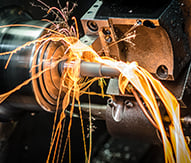
Some CNC machine shops shy away from hard turning because they’ve heard tales of how complex and difficult it is to employ. Yet many others have found that, once they better understand the process, there are significant benefits including eliminating investment in specialized grinding equipment, and the ability to perform multiple CNC machining operations with one setup, thus improving throughput and reducing cost-per-part.
So what do you need to know about hard turning to decide if it can help your productivity? Here are 7 facts to consider:
- By definition hard turning is performed on steel with hardness values of 45 Rc or above, and typically in the 60 – 68 Rc range.
- A key factor is the ability of the machine tool to perform this function based on its rigidity and vibration damping characteristics. This is critical to achieving the micro-finishes commonly achieved through grinding operations.
- Rigidity and vibration control begin with a CNC machine’s base structure and turret construction. The machine must be designed and built from the ground up to be extremely stable with excellent damping characteristics.
- An integrated tool holder that securely holds tools with minimum overhang also helps to reduce the transmission of vibration to the cutting area.
- Another critical consideration is using the proper tools for each application. Carbide inserts are acceptable for materials in the 40 – 50 Rc range. Ceramic inserts are a good choice for metals in the 50 to 55 Rc range including casehardened mild steels with low carbon content. CBN (cubic boron nitride) is the insert of choice for materials beyond 55 Rc including casehardened and most through-hardened steels.
- The key to determining which CBN insert to use is the material’s carbon content. For example, high carbon content materials are very abrasive and therefore require an insert with greater CBN and less ceramic binding. For low carbon content steels you can use inserts with higher ceramic binding content.
- Successful hard turning also requires establishing the best process strategies for each application. For example, a one-cut strategy is quicker, has a shorter cycle time and uses one tool position. However it may not deliver as precise surface finish or roundness as a two-cut strategy.
For more about hard turning and other machining challenges, talk to your Torrance Haas Factory Outlet consultants. They have the experience to answer your questions, and the new ST generation of Haas CNC lathes and turning centers that have the rigidity and features you need for greater productivity. Watch a video demo of the ST-10, then learn more by calling (310) 381-0750, email: jphillips@haasfactoryoutlet.com, or visit www.haasfactoryoutlet.com.